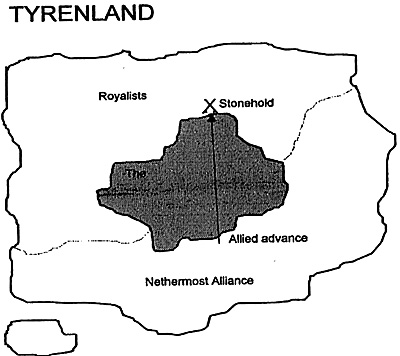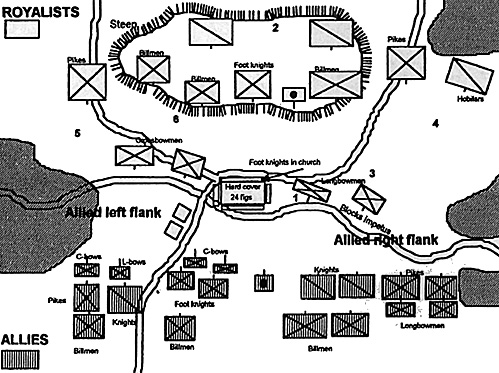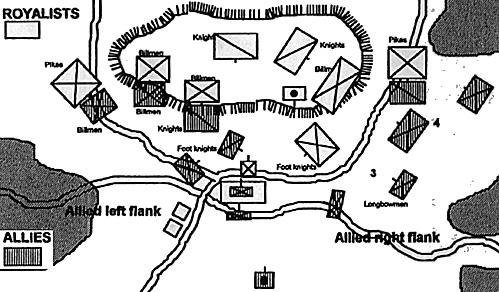Background
 This battle was played recently, at the
Dragonflight convention in Seattle.
This battle was played recently, at the
Dragonflight convention in Seattle.
The battle was taken from a medieval miniatures campaign which myself and a few friends had been playing.
In the campaign, the players had divided (very roughly, and with some shifting about) into two camps. The first were the *royalists" who were holding the young Prince Edwin, to'guide' him until he assumed the throne. The second was the 'Nethermost alliance', a group of barons who wanted to rescue Edwin from the evil advisors surrounding him, so that they could guide his decisions. The royalist players were generally in the north, with the Nethermost Alliance in the south. Refer to the generalized campaign map below to see the strategic situation.
The allies had advanced their main army northward, through the large central forest taking up the middle of the island. The royalists, with a somewhat smaller army, awaited them in a good defensive position, at the large stone church known as Stonehold. Here there were fords across a small river that the allies would have to cross.
The Rules
We played the battle using the Flamberge rule system, a set of 1:20 scale miniatures rules composed and published by myself. The game lasted from 7:30 PM to about 11:30 PM, when a decision had been reached.
There were eight players. Only two had actually signed up on the sign-up sheet for the game; these two became the army leaders for each side.
In Flamberge, there are four armor classes of troops: Armored Infantry or cavalry (Al or AC), Heavy (HI or HC), Medium (Ml or MC), and Light (LI or LC). There are also heavy and light guns. Troops may be one of five morale grades, A, B, C (average), D, or E.
The Forces
The armies were composed of the following troops:
Royalists (defenders):
5 Leaders
2 light guns + 4 crew each (Grade C LI)
72 Billmen (3 units of 24) Grade C HI with
polearm
48 Dismounted knights (2 units of 24) Grade
B Armed with polearm
72 Pikemen (2 units of 36) Grade C HI with
pike
24 Crossbowmen (2 units of 12) Grade D Ll
with crossbow - may skirmish
24 Longbowmen (2 units of 12) Grade C LI
with longbow - may skirmish
36 Mounted knights (2 units of 18) Grade A
AC with lance
18 Hobilars (1 unit of 18) Grade B HC with
lance
Nethermost Alliance (attackers):
5 Leaders
1 heavy gun + 4 crew (Grade C LI)
2 light guns + 4 crew each (Grade C LI)
96 Billmen (4 units of 24) Grade C HI with polearm
48 Dismounted knights (2 units of 24) Grade B Armed with polearm
88 Pikemen (2 units of 32, 1 unit of 24) Grade C HI with pike
36 Crossbowmen (3 units of 12) Grade D LI with crossbow - may skirmish
36 Longbowmen (3 units of 12) Grade C LI with longbow - may skirmish
36 Mounted knights (2 units of 18) Grade A AC with lance
18 Hobilars (1 unit of 18) Grade B HC with lance
The two armies set up (more or less) as shown on map.
The Game Table, Terrain, and Victory Conditions
The game table was about 6 feet deep and 8 feet across.
The weather had been very dry (it was late spring). As a result, the small river was nearly empty; its only effect would be to block the impetus bonus for charging troops.
The stone church was hard cover, and could hold 24 figures. The other two houses were soft cover, and each could hold 12 figures.
The large hill was steep. Troops charging up its contour slope would lose their impetus, and move at half speed.
The woods were simply "woods", as stated in the rules. Basically, troops inside them would move at half speed.
To win, the allies would have to capture both the stone church, and push past the crest-line of the large hill.
Initial Positions
Before starting the game, I warned the players to be careful and keep aline of battle', especially with their infantry. Infantry suffers a morale penalty if it has 'open' flanks (no friends within 4"), and a severe combat penalty if fighting cavalry with either flank . open'. I pointed out how annoying it can be to see a strong pike block unable to fend off cavalry, because the pikes do not have their flanks covered properly. I also warned them not to crowd units up behind one another. If a unit is forced to retreat, it may crash into friends behind it, which causes severe problems for them.
The royalists, as shown in the first map below, put their best troops into the church (as expected), and set up their main battle line along the edge of the steep hill. They put their missile troops along the edge of the river, to do damage and fall back as the enemy advanced.
The allies had a more difficult task. they had to decide whether to capture the church first, then take on the hill, or try to bypass the church and attack the hill. They decided on the latter course, and set up accordingly. They left their center relatively weak -- after all, the knights were unlikely to leave the church - and set up two pincers to attack the hill from two sides.
Neither side elected to put their missile troops in skirmish order. In the rules, a unit must be placed in skirmish at the start of the game, and cannot later form up. Skirmishing also reduces shooting power somewhat. Loose order troops roll one die per three figures, while skirmishers roll one die per four figures.
Their left-flank general had become enamored of overhead fire, and put his longbowmen behind his two pike blocks. This would protect them, but their fire would be multiplied X 1/3 (Flamberge treats all overhead shooting as long range).
The Course of the Battle
The battle progressed for the first few turns without too much action. The players quickly learned the mechanics of shooting, and the missile troops began to inflict some losses on each other.
The allied left flank swung around the church and managed to cross the river with no trouble.
The allied crossbowmen and artillery in the center shot sporadically at the church. However, armored infantry in hard cover take very few losses from shooting, and it became obvious that an assault would be needed. This was something the allies seemed unwilling to do, at least for the present. Instead, they directed their foot knights and billmen around the church, in order to assault the hill.
The allied right flank saw a lot more action during the first part of the battle. One of the allied knight units charged a unit of longbowmen ('I"). Troops in loose order have a chance to evade, needing a 4-6 on one die (skirmishers may always evade). The bowmen failed to evade, and were quickly routed by the knights.
The player owning the knights now discovered, to his dismay, that the knights would need a'6'on one die to stop pursuit. Worse, if the knights pursued off the table, they would not return! Their only real hope was to wipe out the bowmen before reaching the edge of the table. The knights pursued to position "2".
At that point, one of the royalist units swung onto their flank and in turn routed them. Since the knights could not avoid contacting any enemy units during their initial rout move, they were forced to surrender. I ruled that the winning unit would spend one turn collecting prisoners.
The allied pikemen on the right advanced at a leisurely pace, with their supporting longbowmen doing little or no damage, due to penalties for overhead shooting. One of the allied bill units charged the other royalist longbow unit ('3'), which again failed to evade, and was routed. infantry, however, rallies much more easily than cavalry (4- 6 base to pass test), and the billmen did not pursue.
Still on the right flank, the royalist hobilars charged the remaining allied knight unit (position "4"). A long combat ensued, while the pikemen on each side either watched, or began edging around the swirling mass of horsemen (Flamberge forbids infantry from charging cavalry). The hobilars, although badly outclassed, fought until wiped out. At that point, they counted as a routing unit, but caused no other troops to rout. In the rules, a 'hit' represents 'loss of effectiveness' (a typical wargame dodge); this means that the hobilars fought bravely until they could fight no more, then disintegrated.
Back on the left flank, the allies successfully rounded the church, and a line of combats began for possession of the hill (positions '5" and V). The royalist foot knights actually left the church, trying to get behind the allied line, but were in immediate difficulties.
When a unit leaves a building, It must stand shaken for one turn to get organized. During this time, the knights were attacked and only stood their ground with difficulty. To make matters worse, one of the allied crossbow units promptly scrambled into the church. the allied had achieved their first victory condition via a give-away.
On the right, meanwhile, the allied knights now charged the royalist pike block. Even though they were attacking pikes frontally, on tired horses (Flamberge gives cavalry one .good" charge - thereafter, the cavalry has a much-reduced impetus factor), they were managing to hold their own because the pikes had an open flank. This gave the cavalry 2 extra combat points.
On the left, the line of combats was going against the allies, who were attacking (for the most part) up a steep slope. This robbed them of impetus, and kept them from counting depth in their attacks. The allied pikemen on that flank routed, as did one of the bill units.
On the right, the other royalist foot knight unit had come down off the hill and routed one of the allied bill units. the foot knights were in position to possibly assault the church and retake it.
At this point, as it was getting late, I called the battle a minor Royalist victory, and none of the allies was really willing to dispute the point.
I have unfortunately forgotten or glossed over many details of the battle (the travails of the royalist guns, the long, hard pike battle on the allied left, etc.). This Is due to trying to run the game and keep in mind something of what was actually happening. I suppose the old saw about truth being the first casualty of war applies to these games as well.
Analysis
I believe the allies might have done better to place their bowmen in skirmish order on the left, in advance of the pikes. This would have let them do a lot more damage as they advanced.
Alternatively, they could have been massed in the center with the crossbows and artillery, to start wearing down the knights in the church. A unit becomes "exhausted* after suffering 50% losses; it would have taken only 12 hits to exhaust the knights, at which time the allied foot knights could have assaulted the church. in the event, of course, the knights left the church, so the point is moot.
Everyone played well, especially considering none of them knew the rules. The players picked up the shooting, turn sequence, and movement mechanics within a turn or two. Combat was a bit more complicated, but they seemed to grasp these mechanics fairly well also.
Stonehold seems like a well-balanced scenario, which everyone (except one player, who was having a "one of those battles") enjoyed; I will probably put it on again at a later convention.


Back to Citadel Autumn 1998 Table of Contents
Back to Citadel List of Issues
Back to MagWeb Master Magazine List
© Copyright 1999 by Northwest Historical Miniature Gaming Society
This article appears in MagWeb (Magazine Web) on the Internet World Wide Web. Other military history articles and gaming articles are available at http://www.magweb.com